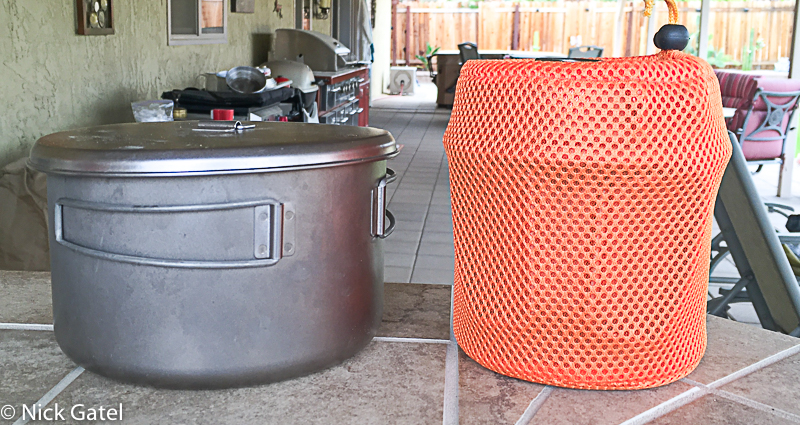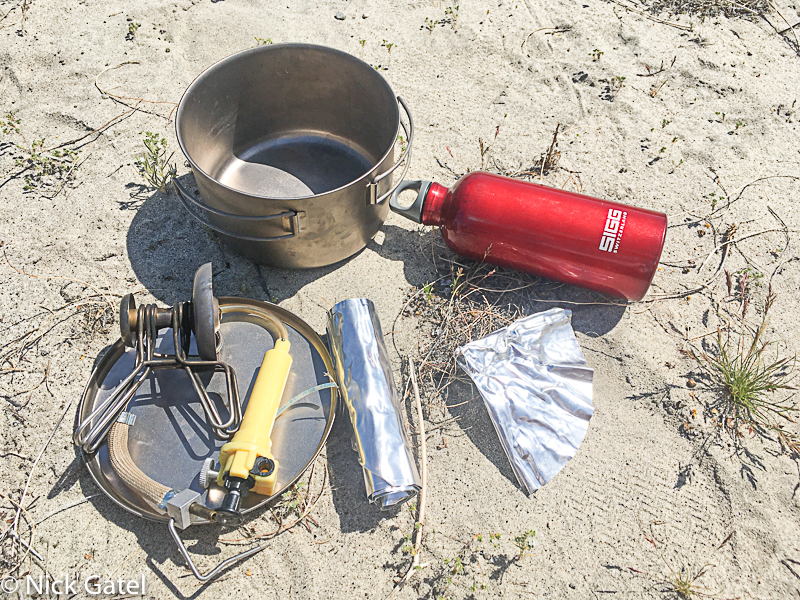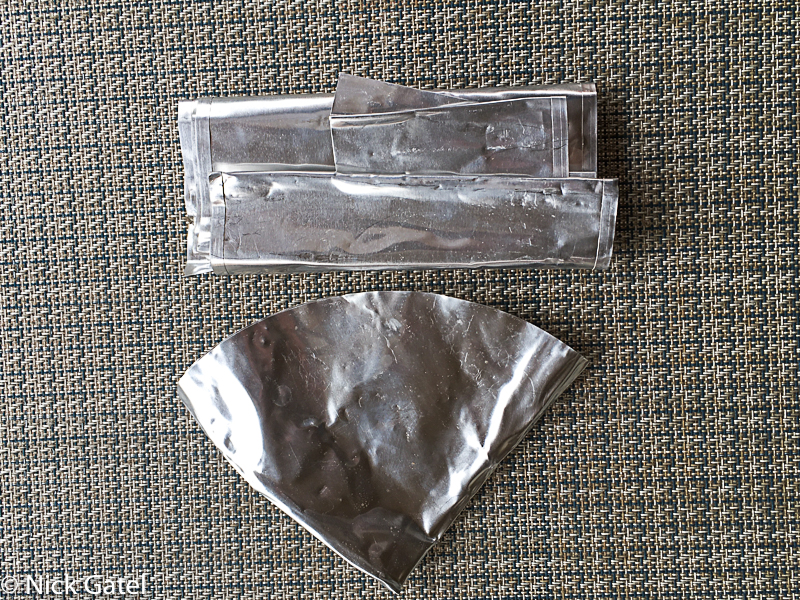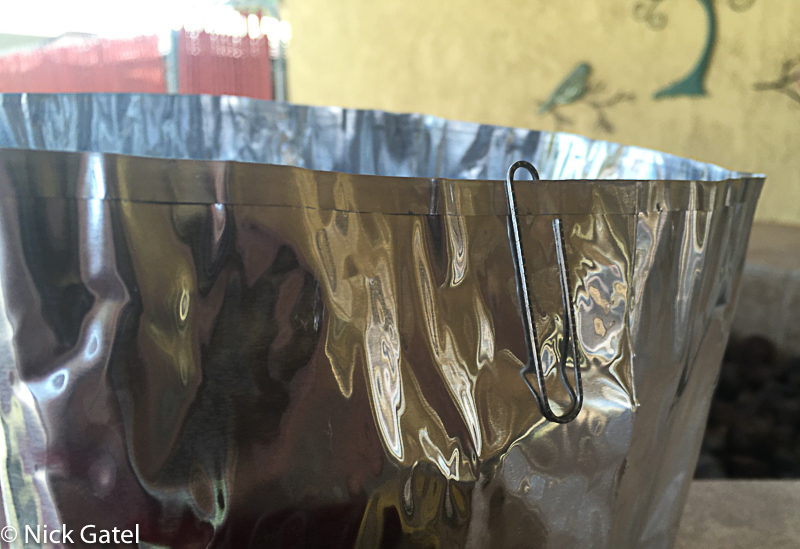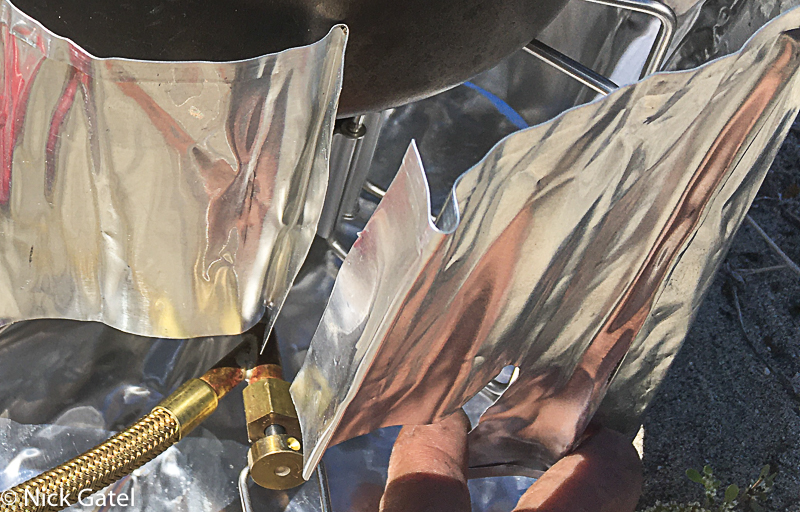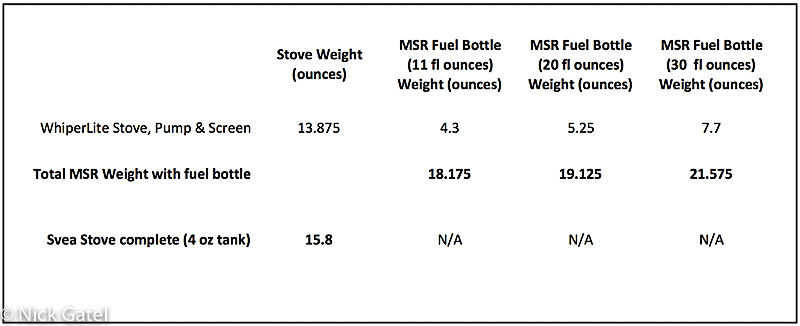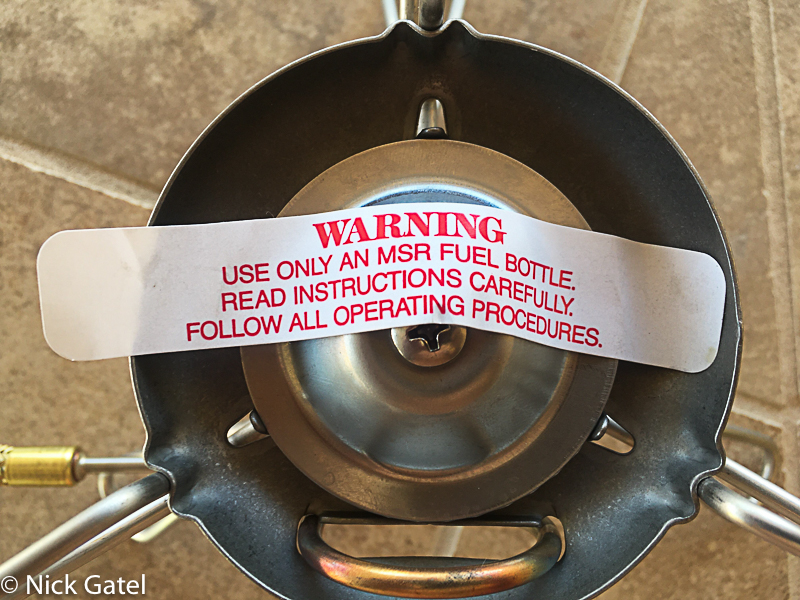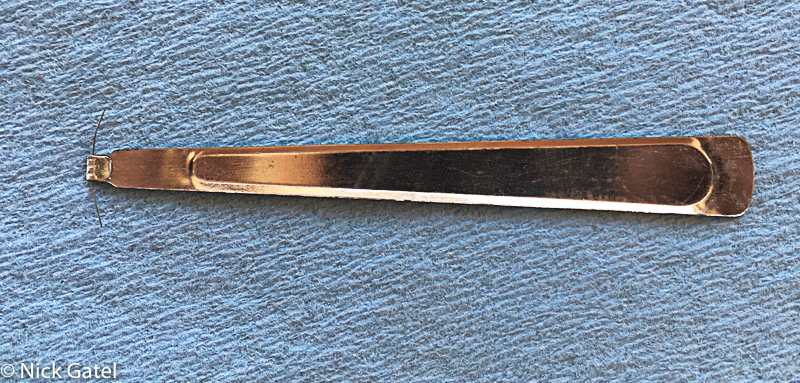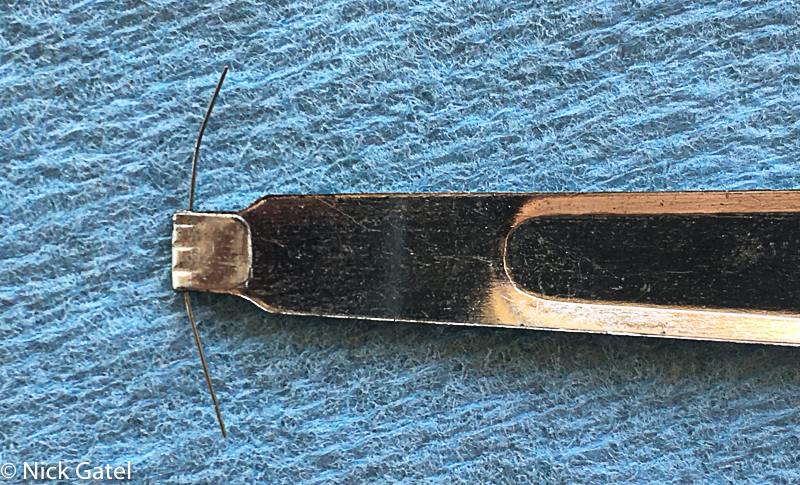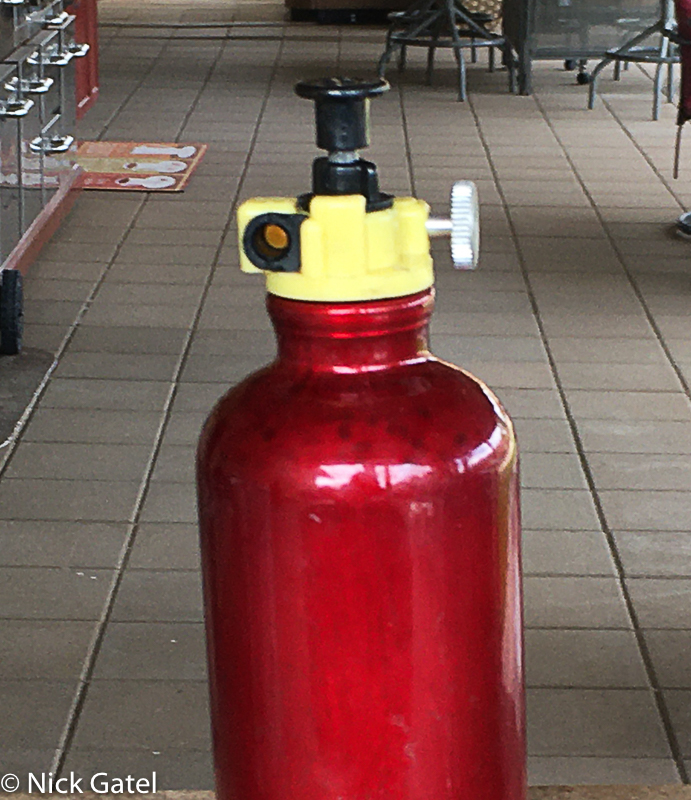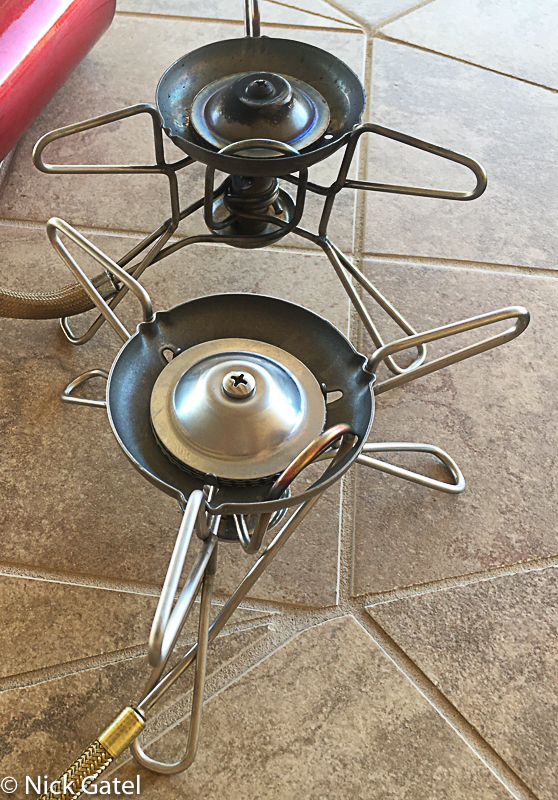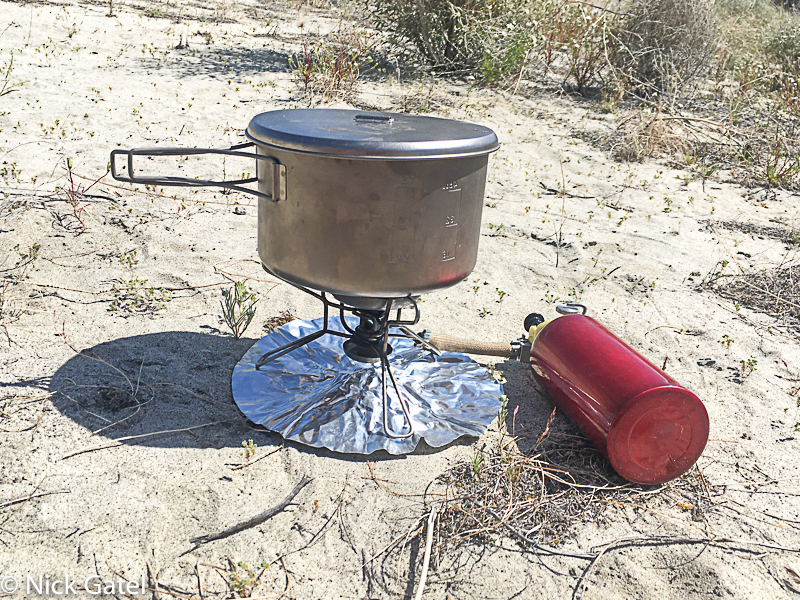
A few day ago I wrote about the Svea 123 backpacking stove and wrote,
The Svea 123 is probably the most reliable backpacking stove ever made. It is by far my favorite stove. It doesn’t do any one thing particularly well, but it ALWAYS works. Mine has worked flawlessly for 48 years.
The Svea 123 is an industrial work of art. It is aesthetically pleasing. Made of brass, over a period of time it develops a nice patina. However, as I stated, it doesn’t do any one thing particularly well.
The past year I have been using the WhisperLite more and more; to the point I recently bought a new version of the WhisperLite. In this post I’ll review the features and benefits of the WhisperLite and compare the original version to the newest offering.
The Mountain Safety Research (MRS) WhisperLite does many things well. First introduced in the ’80s, it has been “improved” several times and is still in production. It is probably the most popular backpacking stove (in terms of units sold) ever produced.
One problem with backpacking stoves, prior to the first MSR stove, was the fuel tank, which was part of the stove body. These stoves were subject to wind, making them inefficient in wind, and often difficult to keep lit. Many users would add an external windscreen to them, which often overheated the tank, resulting in explosions and even death.
Larry Penberthy, one of the founders of MSR, solved this problem with a remote fuel tank that allowed an effective windscreen to surround the stove burner without overheating the fuel tank. He incorporated a fuel pump to pressurize the remote tank. Thus, in 1973, MSR released the Model 9 stove.
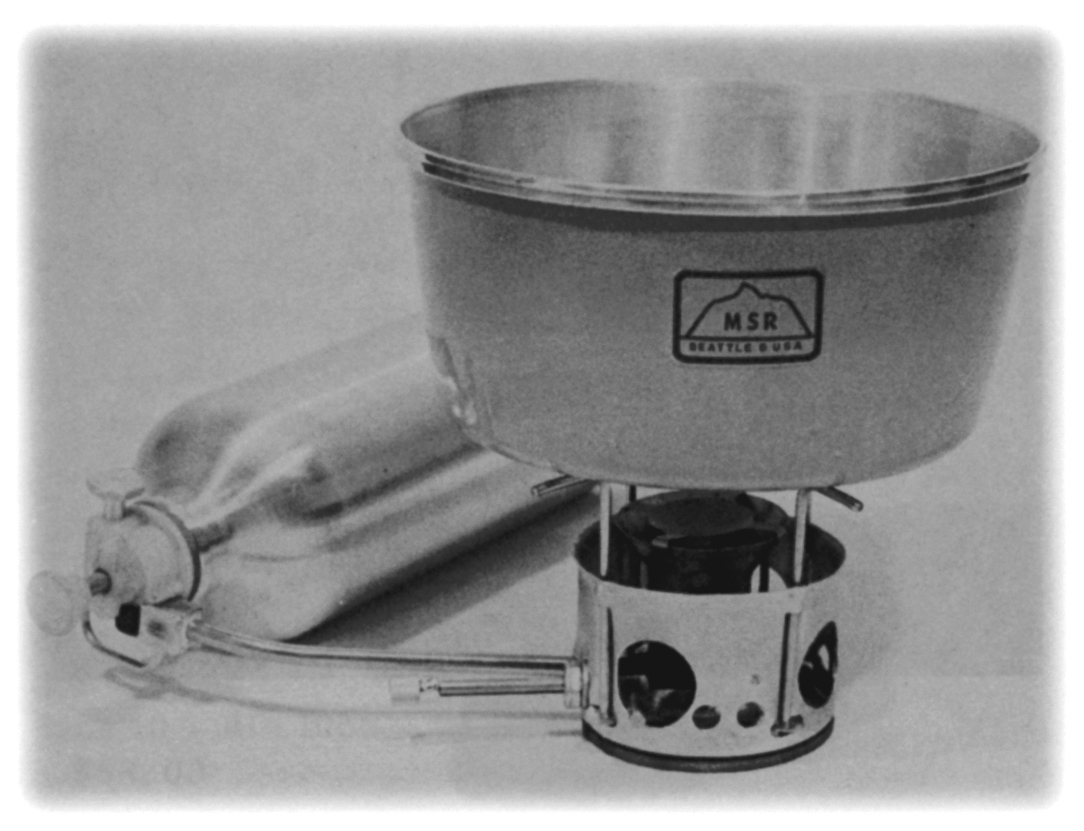
The stove was heavy, and the fuel feed, from the tank to the stove, was a solid tube, requiring disassembly to pack it up. In a short time, the Model 9 became the favorite of mountaineering expeditions. The fuel tank was an aluminum bottle with a fuel pump that screwed into the threads of the bottle, when the cap was removed. In those days, MSR did not make their own bottles and recommended the Sigg brand fuel bottles.
In the early ’80s MSR introduced the WhisperLite. A flexible fuel tube did not have to be removed to pack up the stove, meaning the stove, pump, and windscreen could be packed into a fairly small pot, protecting the stove and saving space inside a backpack.
Everything fits into this 1.5 liter pot
The pictures below are of the original WhisperLite I bought circa 1985. The new version is almost exactly the same.
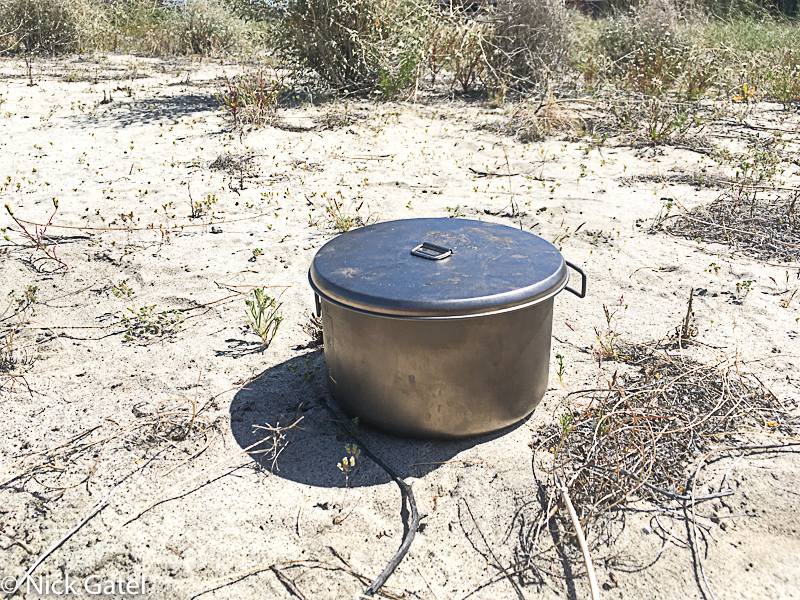
The ground reflector and windscreen are made from thin aluminum (or thick aluminum foil, if you please), making it easy to pack and adjust to the pot size.
Liquid Stoves versus Gas Stoves
“Liquid” Fuel
Like the Svea 123, the WhisperLite runs on liquid fuel. I should point out the difference, especially the nomenclature used by most folks who use these portable stoves. Liquid fuel is sold in bulk and can be transferred into other containers. The most common is “white gas” and the best known brand is Coleman Fuel.
“Gas” Fuel
Nowadays, this is usually isopropane fuel in a sealed canister. It is not intended to be transferred to other containers, and fuel delivery is a vapor gas, unless the canister is turned upside down. Upside down, the canister will deliver liquid fuel and for most backpacking stoves, it is a dangerous situation. There are a few stoves that can use these canisters in an inverted position, such as the MSR WindPro backpacking stove.
Fuel Logistics
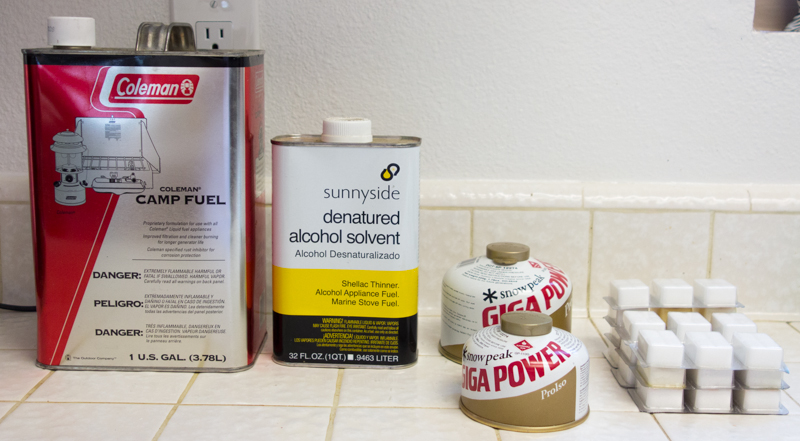
A gallon of white gas contains 128 fluid ounces. The most common canisters come in 8 fluid ounces and 4 fluid ounces. It would take sixteen 8 oz. canisters or thirty-two 4 oz. canisters to match a single gallon of liquid fuel.
Today you can buy a gallon of Crown brand white gas for as little as $8.86 at Walmart. The last gallon of Coleman Fuel I bought was $14.95.
Not all canister fuel is equal, and many “off brands” contain contaminates that can plug up a canister stove. Unlike a liquid fuel stove that is easy to clean the jet, cleaning jets on a canister stove usually requires disassembly of the stove, and most backpackers don’t carry the required tool for these kinds of field repairs. For this reason, I prefer MSR or Snow Peak brand canisters. A 4 oz. (110g) MSR canister retails for $4.95 and $5.95 for the 8 oz. (225g) size. So let’s do some comparison.
- 128 ounces of white gas = $14.95
- 128 ounces of MSR IsoPro (sixteen 8 oz. canisters) = $95.20
- 128 ounces of MSR IsoPro (32 4 oz. canisters) = $158.40
Keep in mind that I am not comparing apples to apples – the fuels and stoves are different. I probably use around 1.5 ounces per day in a liquid stove and about 1 ounce (or a little less) in a canister stove. Here is a cost table I included in this post comparing four types of stoves and fuel.
Why I Bought the WhisperLite in 1985
The WhisperLite could handle larger pots than the Svea, was more stable, and, most importantly, handled wind much, much better. I used it primarily for winter camping in the mountains, where melting snow for water is a daily task. The larger tank (fuel bottle) allowed the stove to operate longer.
For me, the WhisperLite has been mostly a winter only stove. I also use it when I expect a lot of wind, such as we get in the desert during the beginning of spring and the beginning of fall seasons. Otherwise, the Svea 123 has been my go to stove for almost 50 years. I have at times, and still do, use other kinds of stoves depending on the trip conditions and length of trip.
A few days ago I wrote about the Sigg windscreen I own for the Svea 123. It works pretty good, it is heavy and it requires a matching Sigg pot to work. For comparison:
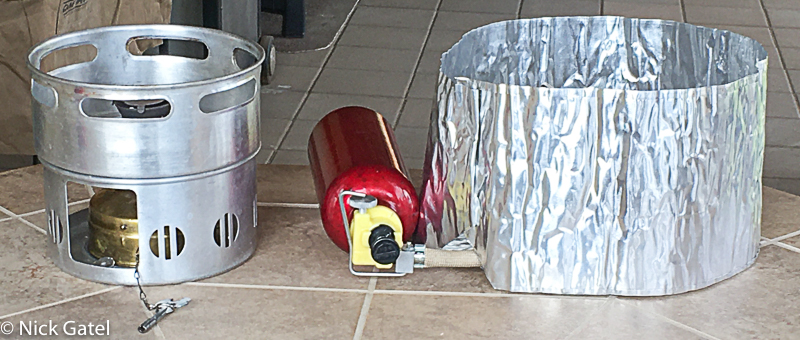
Storing and Using the MSR Windscreen
If the pot is large enough, I just roll up the screen and put it in the pot, as in the photo below.

For smaller pots I just fold it up.
Some people wrap it around their fuel bottle (see below). I don’t like to do this as it increases the chances of ripping something or cutting a finger, although the edges of the screen are rolled over to help prevent this.
When the windscreen is wrapped around the pot, the open ends of the screen can flop around in the wind. There are a couple solutions. One is a big paperclip (which can be used for all kinds of field repairs too) or just folding over the ends, interlocking them, and pressing everything together… no tools needed!
Weights:
- Sigg windscreen = 6 5/8 ounces
- Svea included windscreen = 4 1/4 ounces
- MSR windscreen & the base reflector = 2 1/4 ounces
Obviously the MSR is much more packable.
If you wear out the MSR windscreen or lose it in a hurricane or tornado, they are readily available.
This website may be compensated for linking to other sites or for sales of products. As an Amazon Associate I earn a small fee from qualifying purchases at no additional cost to the purchaser.
Comparing the weights of windscreens is really kind of silly. With the Svea you have to use a windscreen to operate it; the windscreen is also the pot holder. The WhisperLite can be used without the windscreen, but MSR states the windscreen must be used to separate the fuel bottle from the stove. I have found without the windscreen the MSR fuel bottle gets hot – a potential hazard. With the windscreen the fuel bottle is never hot to the touch.
MSR lists the minimum weight of the WhisperLite at 11 1/5 ounces (stove + pump), a measurement that is worthless. You need a fuel bottle and windscreen to operate it. So lets look at some real weights.
The new WhisperLite weights 1.5 ounce more than the old one I own. The only real difference I can see is the fuel hose of the new stove is longer and made of braided steel vs. a fire resistant fabric covering a reinforced rubber compound hose. Since one cannot buy a new ’80s model stove, let’s look at the different weights with the three bottle sizes offered by MSR, and let’s compare those to a complete Svea 123.
The Svea wins on weight by quite a bit. But weight isn’t the whole story. The Svea only holds 4 ounces of fuel, so on most trips you need to carry an additional fuel bottle. With the WhisperLite, I normally carry just the 11 ounce bottle. If I need more fuel, I usually carry it in the same type of bottle I use with the Svea, a brown liquid P.E.T.E. re-purposed prescription mouth wash bottle that weighs just 1.75 ounces. You cannot use the P.E.TE. bottle with a MSR pump, of course.

Speaking of bottles, I must point out that MSR now ships their bottles with a child-resistant cap. It is a royal pain in the ass. Not only is it a pain in the ass, it weight a full 1/2 ounce more than the old style cap.
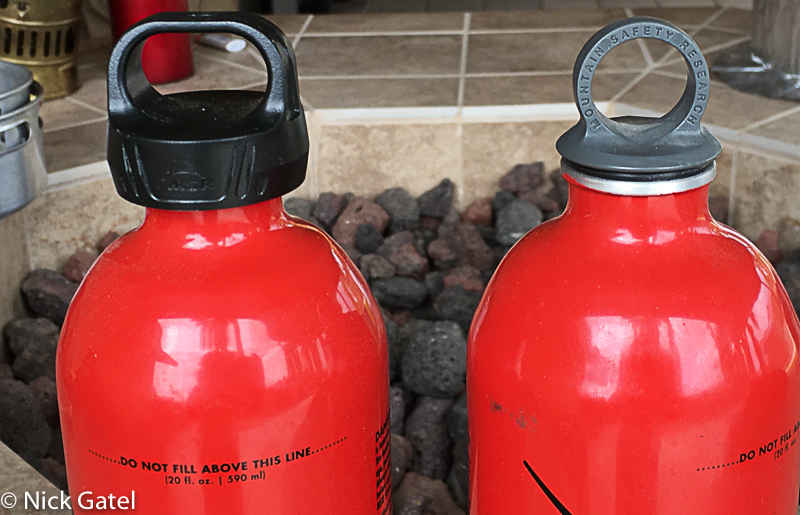
The good news about this awful new cap is you can still buy the old style cap.
One other point about fuel bottles. Originally, when MSR released their first stove they did not make fuel bottles, but sold Sigg fuel bottles. In my ’80s instruction manual, MSR recommends using their bottles or Sigg fuel bottles.
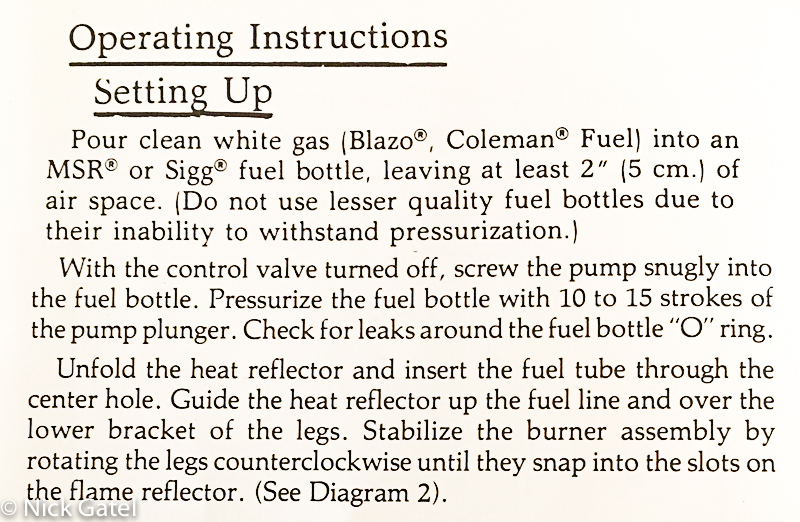
But…
They new stove says to only use MSR bottles. Is this a marketing ploy?
No.
I found this out about 10 years ago. I had several Sigg bottles that were pretty beat up from hard use over the years. Dents, etc. I decided to replace all of them, except one that was nearly new. My research found that there was indeed a difference between the Sigg and MSR bottles.
MSR bottles are made from single piece impact-extruded lightweight aluminum. The Sigg bottles use a separate threaded piece that is inserted into the bottle and then crimped to the top of the neck. Not only can they leak, but if the threaded part comes loose with the cap tightly sealed, it will be impossible to remove the cap without damaging everything.
Sigg no longer makes fuel bottles, so if you buy a new Sigg bottle it is a water bottle. Liquid fuel is very flammable, so why take a chance? Just buy a MSR bottle and be done with it.
Auto Amazon Links: No products found.
The Old versus the New WhisperLite
So why did I buy a new one?
Quick answer, I was concerned about the age of the original’s fuel hose. It is made from a reinforced rubber compound and covered with a fire resistant sheath. Over the years the hose has developed a “flat spot” from bending it to store in pots. Having an automotive background, I know that fuel hoses deteriorate over time.


The hose can probably be replaced, if the inner diameter is a common size; and I do have those kind of clamps and pliers to crimp it. But, these stoves with the yellow pump can be sold on eBay for more than the cost of a brand new one. So, I’ll retire the old one.
But what are the differences?
Pumps
The first obvious difference are the pumps. The old one is Yellow and no longer available. The new one is black with red trim and fits all MSR liquid stoves except the DragonFly. MSR also makes an “arctic” pump (black with blue trim) for extreme cold, and lastly an all red pump that fits only the MSR DragonFly stove. I’ll review the DragonFly stove in a few days.
Auto Amazon Links: No products found.
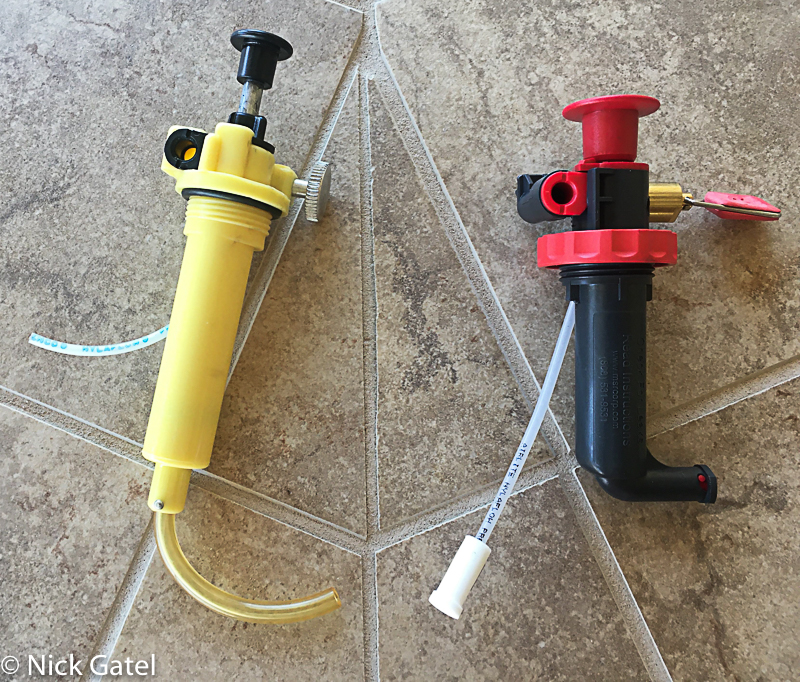
In case you’re wondering, the yellow pump does work with the new model WhisperLite.
What is interesting is the manual for the ’80s WhisperLite says to pressurize the bottle with 10-15 strokes.
But the new WhisperLite instructions says to prime the fuel bottle 20-30 times. What gives?

Let’s take another look at the old yellow pump versus the new one.
The yellow pump body is longer and it has a metal plunger. You can see the diameter of the metal plunger is also much narrower than the plastic plunger in the newest pump.
Aha, the old pump draws in much more air per stroke to pressurize the bottle.
Over the years MSR has updated their pumps several times. Users used to complain that the old yellow pump was better and more reliable. I have heard the newest pump is much better than its predecessors (other than the yellow pump).
POOF!
Priming the stove is much like priming the Sea 123, which I wrote about in great detail in this post.
Pressurize the bottle, open the control valve 1.5 turns until about 1/2 spoonful of fuel dribbles into the priming bowl (how much is 1/2 spoonful?).
Close the valve and light the fuel in the priming bowl.
Now, as with the Svea, you’re gonna get a flare up. As with both the Svea 123 and the WhisperLite, new users sometimes freak out over this. Apparently it happens a lot, and the new MSR instruction sheet warns the user:
A brief soccer ball-sized flame is normal.
Okay, you’ve been warned, although I rarely get a flame this big. Practice makes perfect! And don’t light the stove in your tent.

Maintenance Kit
’80s WhisperLite
This stove came with a wire jet picker. Like the Svea 123, this is used to clear the jet of any obstruction or carbon build up.
The wire is fragile and I always carry it in my first aid kit, between a couple items so it lays flat and can’t be damaged.

New Model Maintenance Kit
Note that there is no jet pricker. Just a wrench, one o-ring, and pump cup oil.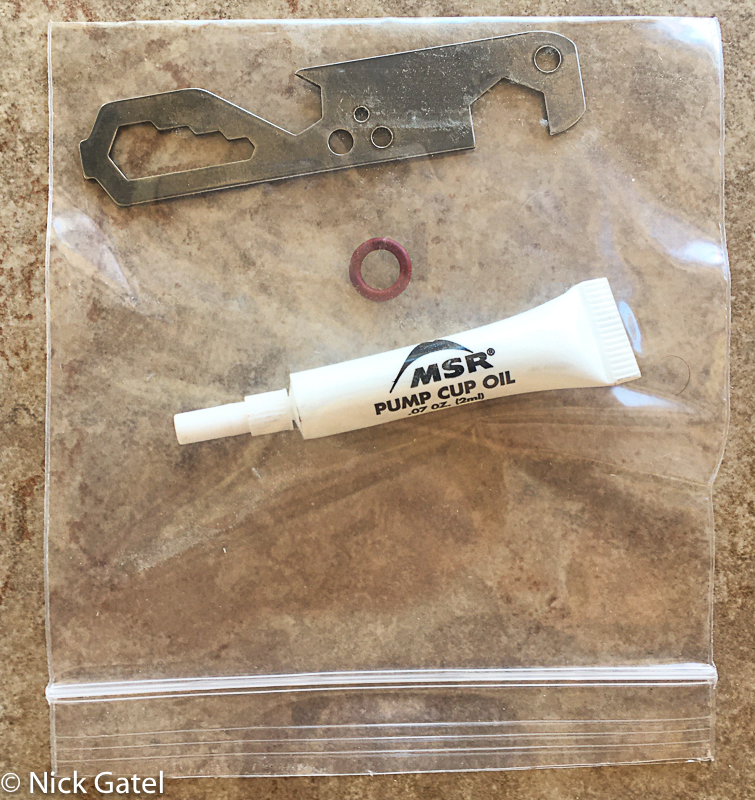
The newer WhisperLite stoves have a “shaker jet” built in. Just shake the stove up and down (when the stove is cool and disconnected from the fuel bottle) and it will clean the jet. I always do this after each use. It doesn’t take long and prevents carbon build up.
Also, since I always store the stove in a pot, I clean the exterior carbon build up after each use. Keep the inside of my pot clean and avoids and ugly stove that will take elbow grease to clean if not wiped off frequently.
Also, I store the fuel pump in my cooking pot to protect it and keep dirt out of the fitting where the fuel line connects (see below).
MSR sells an annual maintenance kit and an expedition kit for a major overhaul of the stove and pump. Having worked on cars for decades, I’m into the recommended maintenance of anything I own. It’s a good idea to keep one of each on hand.
Fuel Lines
Aside from the pumps, the most obvious difference in the two models is the fuel hose. The newer one has a braided hose and is much longer – a big improvement in my opinion.

Other than the fuel lines, the stoves look almost identical. Good to see a company not change something that works well.
Operating in Really Cold Weather
The coldest I have ever used a WhisperLite was 5 degrees Fahrenheit, with no special methods needed. The stove worked perfectly. As mentioned earlier, there is a special pump for “arctic” conditions.
Some people wrap duct tape around the fuel bottle to prevent damage to their unprotected hands. Being a desert rat for almost 50 years, I always wear gloves whenever the temperature goes below freezing. I have used this stove so often, that handling and setting it up is easy for me with thin glove liners.
MSR Liquid Stoves
MSR makes three versions of the WhisperLite:
- WhisperLite
- WhisperLite International
- WhisperLite Universal
WhisperLite
This is the stove I have just spent 2,500 words reviewing.
WhisperLite International
This is a multi-fuel stove and burns:
- white gas
- kerosene
- unleaded auto fuel
WhisperLite Universal
Similar to the International but also can use gas canisters.
- white gas
- kerosene
- unleaded auto fuel
- IsoPro canisters
Other liquid stoves:
XGK™-EX
This is a heavier expedition stove and can burn:
- white gas
- kerosene
- unleaded auto fuel
- diesel fuel
- aircraft jet fuel
DragonFly
The above stoves work best to boil water and don’t do a good job if you need a low simmer flame. The DragonFly simmers like you home stove. It can burn
- white gas
- kerosene
- unleaded auto fuel
- diesel
- jet fuel
It also handles large pots (up to 10″ in diameter) and is very stable. I’ll be reviewing this stove in a few days.
Although, not a liquid stove, the MSR WindPro II can burn liquid IsoPro canister fuel (with the canister inverted). It really is a great little stove, and I’ll be reviewing this stove tomorrow or the next day.
Comparison
